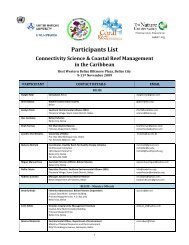The Global Water Crisis: Addressing an Urgent Security - Unu-inweh ...
The Global Water Crisis: Addressing an Urgent Security - Unu-inweh ...
The Global Water Crisis: Addressing an Urgent Security - Unu-inweh ...
Create successful ePaper yourself
Turn your PDF publications into a flip-book with our unique Google optimized e-Paper software.
Table.1. <strong>Water</strong> pollut<strong>an</strong>ts <strong>an</strong>d hum<strong>an</strong> health impacts (adapted from P<strong>an</strong>gare et al., 2006).<br />
Pollut<strong>an</strong>t Pathway into water Impacts<br />
Arsenic � Natural occurrence in<br />
groundwater<br />
Fluoride � Natural occurrence in<br />
groundwater<br />
� Artificial introduction to<br />
groundwater through mining<br />
Nitrate � Artificial introduction to surface<br />
water through use of fertilizers<br />
<strong>an</strong>d industrial wastewaters<br />
� Nitrate-based fertilizers applied<br />
excessively leaches into<br />
groundwater<br />
Persistent<br />
org<strong>an</strong>ic<br />
pollut<strong>an</strong>ts<br />
(POPs)<br />
Heavy<br />
metals<br />
� Surface run-off contaminated<br />
with herbicide <strong>an</strong>d pesticides<br />
� Herbicide <strong>an</strong>d pesticide leaching<br />
into groundwater<br />
� Natural occurrence<br />
� Discharged as effluent from<br />
m<strong>an</strong>ufacturing, mining <strong>an</strong>d<br />
thermal power pl<strong>an</strong>ts<br />
<strong>Water</strong>-related diseases are caused by consumption or contact with water contaminated with pathogens such as bacteria,<br />
parasites or viruses. Contamination may occur at source, en route while passing through poorly laid <strong>an</strong>d maintained pipelines,<br />
or at water storage facilities that have not been effectively secured. Source contamination occurs at unimproved open<br />
water sources, such as lakes <strong>an</strong>d rivers. <strong>The</strong>se open sources are used for multiple purposes, including in situ bathing <strong>an</strong>d<br />
washing, which facilitates the tr<strong>an</strong>sfer of germs from infected individuals to the water bodies. Poor water infrastructure<br />
allows pathogens from the surface or the surrounding substrata to enter the water supply; this is especially critical when<br />
sewer systems are similarly inadequate as sewage may mix with drinking water. Stored water that is left uncovered <strong>an</strong>d<br />
stagn<strong>an</strong>t provides vectors such as mosquitoes with breeding grounds, <strong>an</strong>d encourages the proliferation of pathogens.<br />
Health risks related to poor water <strong>an</strong>d s<strong>an</strong>itation facilities are termed ‘traditional risks’ (WHO, 2009), <strong>an</strong>d are typically<br />
associated with poverty. <strong>The</strong>se risks are commonly seen in developing countries, but permeate developed countries as<br />
well, particularly in marginalized communities such as those living in slums or in rural areas. <strong>The</strong> World Health Org<strong>an</strong>ization<br />
in 2009 estimated that in low-income countries, water-related diseases are the second leading cause for loss of healthy<br />
life, <strong>an</strong>d the fourth leading cause of death (WHO, 2009).<br />
About half of all water-related diseases are linked with pathogens found in hum<strong>an</strong> excreta (P<strong>an</strong>gare et al., 2006). <strong>The</strong>se<br />
diseases are categorized as diarrheal diseases, <strong>an</strong>d are responsible for 2 million deaths each year. Other diseases related<br />
to water are those that are vector-borne, or water-washed (related to person-to-person contact) (see Table 2).<br />
80 <strong>The</strong> <strong>Global</strong> <strong>Water</strong> <strong>Crisis</strong>: <strong>Addressing</strong> <strong>an</strong> <strong>Urgent</strong> <strong>Security</strong> Issue<br />
� C<strong>an</strong>cer of the bladder, lung <strong>an</strong>d skin<br />
� Birth defects<br />
� Skin lesions<br />
� G<strong>an</strong>grene<br />
� Respiratory ailments<br />
� Dental <strong>an</strong>d skeletal fluorosis<br />
� Gastrointestinal disorders<br />
� Infertility<br />
� Kidney impairment<br />
� Methemoglobinemia in inf<strong>an</strong>ts<br />
� Oral <strong>an</strong>d gastrointestinal c<strong>an</strong>cers<br />
� Vascular dementia<br />
� Absorptive <strong>an</strong>d secretive functional disorders of the<br />
intestine<br />
� Neural tube defects<br />
� Acute poisoning causes skin <strong>an</strong>d eye irritation,<br />
respiratory problems, systematic poisoning <strong>an</strong>d<br />
death<br />
� Continuous exposure causes nervous disorders,<br />
<strong>an</strong>aemia, sterility, mental deterioration, birth<br />
defects, premature birth, neonatal deaths <strong>an</strong>d<br />
c<strong>an</strong>cer<br />
� Multiple health impacts including but not limited to<br />
org<strong>an</strong> damage <strong>an</strong>d failure, impairments in hum<strong>an</strong><br />
development, genetic disorders, c<strong>an</strong>cer




